Related Research Articles
Super Bowl VIII was an American football game between the National Football Conference (NFC) champion Minnesota Vikings and the American Football Conference (AFC) champion Miami Dolphins to decide the National Football League (NFL) champion for the 1973 season. The Dolphins conquered the Vikings by the score of 24–7 to win their second consecutive Super Bowl, the first team to do so since the Green Bay Packers in Super Bowls I and II, and the first AFL/AFC team to do so.
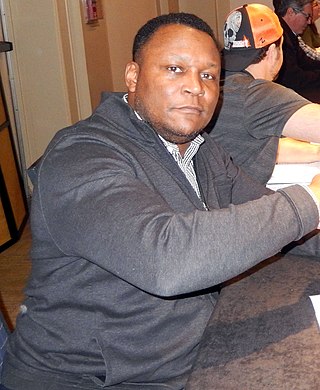
Barry Sanders is an American former professional football running back who played for the Detroit Lions of the National Football League (NFL) for 10 seasons. Sanders led the league in rushing yards four times and in rushing touchdowns once, establishing himself as one of the most elusive runners in the history of the NFL with his quickness and agility, despite being only 5 ft 8 in tall and weighing 203 lbs. Sanders played college football for the Oklahoma State Cowboys. As a junior in 1988, he compiled what is widely considered the greatest individual season by a running back in college football history, rushing for 2,628 yards and 37 touchdowns in 11 games. He won the Heisman Trophy and was unanimously recognized as an All-American.

Gale Eugene Sayers was an American professional football halfback and return specialist in the National Football League (NFL). In a relatively brief but highly productive NFL career, Sayers spent seven seasons with the Chicago Bears from 1965 to 1971, though multiple injuries effectively limited him to five seasons of play. He was known for his elusiveness and agility and was regarded by his peers as one of the most difficult players to tackle.

LaDainian Tarshane Tomlinson is an American former professional football running back who played in the National Football League (NFL) for 11 seasons. After a successful college football career with the TCU Horned Frogs, the San Diego Chargers selected him as the fifth overall pick in the 2001 NFL draft. He spent nine years with the Chargers, earning five Pro Bowl appearances, three Associated Press first-team All-Pro nominations, and two NFL rushing titles. Tomlinson was also voted the NFL Most Valuable Player (MVP) in 2006 after breaking the record for touchdowns in a single season. He played two further seasons with the New York Jets, before retiring. He was elected to the Pro Football Hall of Fame in 2017.

Marion Sylvester Barber III was an American professional football player who was a running back for seven seasons in the National Football League (NFL). After playing college football for the Minnesota Golden Gophers, he was selected by the Dallas Cowboys in the fourth round of the 2005 NFL draft. He was selected to the Pro Bowl in 2007 during his six-year tenure with the Cowboys. He played for the Chicago Bears in 2011.
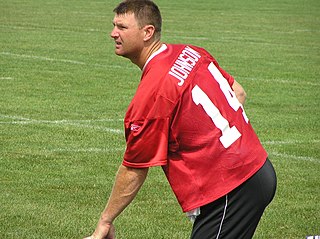
James Bradley Johnson is an American former professional football player who was a quarterback for 17 seasons in the National Football League (NFL), Johnson played for the Minnesota Vikings, Washington Redskins, Tampa Bay Buccaneers, and Dallas Cowboys. He is best known for his time with the Buccaneers, whom he led to their Super Bowl XXXVII title over the Oakland Raiders.
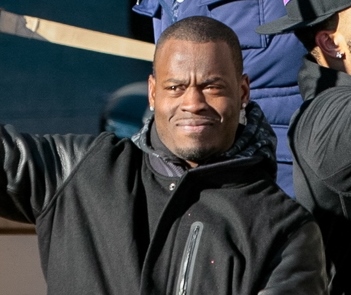
Tarvaris D'Andre Jackson was an American professional football quarterback who played in the National Football League (NFL). Jackson played college football for the Arkansas Razorbacks and the Alabama State Hornets. He was selected by the Minnesota Vikings in the second round of the 2006 NFL draft.
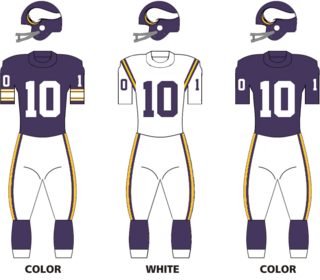
The 1973 season was the Minnesota Vikings' 13th in the National Football League (NFL). With a 12–2 record, the Vikings regained the NFC Central title after having gone 7–7 the previous year. They started the season 9–0 and looked a threat to the previous year's Miami Dolphins' record of a perfect season before losing to the Atlanta Falcons and Cincinnati Bengals in their next three games. Their narrow 10–9 win over the Los Angeles Rams constituted the last time until 1997 that the last two unbeaten NFL teams played each other.
Christopher L. Howard is a former professional American football running back who played in the National Football League (NFL) for the Jacksonville Jaguars. Howard had been drafted by the Denver Broncos in the fifth round of the 1998 NFL draft. His professional football career was haunted by fumble troubles, which caused the Broncos to release him before he played a regular season game for them. Howard began to have fumble problems again when the Jaguars acquired and promoted him to a role as a regular player.
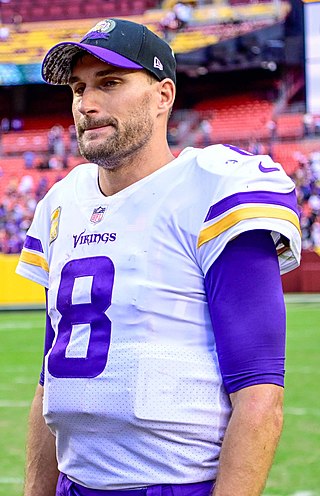
Kirk Daniel Cousins is an American professional football quarterback for the Atlanta Falcons of the National Football League (NFL). He played college football for the Michigan State Spartans and was selected by the Washington Redskins in the fourth round of the 2012 NFL draft. Cousins ranks fourth all-time in completion percentage with at least 1,500 pass attempts and is ninth in the NFL's all-time regular season career passer rating.

The 1974 Michigan Wolverines football team was an American football team that represented the University of Michigan in the 1974 Big Ten Conference football season. In their sixth year under head coach Bo Schembechler, the Wolverines compiled a 10–1 record, outscored opponents 324 to 75, and were ranked #3 in final AP Poll. Michigan won the first ten games of the 1974 season in convincing fashion, including blowout victories over Colorado (31-0), Navy (52-0), Minnesota (49-0), and Purdue (51-0). In the final game of the season, #2 Michigan faced #3 Ohio State. The Wolverines lost by a score of 12-10, as place-kicker Mike Lantry missed a last-minute field goal that would have given Michigan a victory.
The 1945 Michigan Wolverines football team represented the University of Michigan in the 1945 Big Ten Conference football season. In their eighth year under head coach was Fritz Crisler, the Wolverines compiled a 7–3 record and finished the season ranked #6 in the final Associated Press Poll. Quarterback Joe Ponsetto was the team captain, and center Harold Watts won the Most Valuable Player award and was selected as a first-team All-Big Ten Conference player.

Michael John Kafka is an American professional football coach and former quarterback who is the assistant head coach and offensive coordinator for the New York Giants of the National Football League (NFL). After attending St. Rita of Cascia High School in Chicago, Illinois, he played college football for the Northwestern Wildcats, receiving second-team All-Big Ten Conference honors as a senior. He was drafted by the Philadelphia Eagles in the fourth round of the 2010 NFL draft, and spent six seasons in the NFL as a journeyman quarterback. Kafka became the quarterbacks coach for the Chiefs in 2018, and Patrick Mahomes, the starting quarterback for the Chiefs, earned the NFL Most Valuable Player award that season. Kafka helped the team win Super Bowl LIV the following season.
The 1956 Purdue Boilermakers football team was an American football team that represented Purdue University during the 1956 Big Ten Conference football season. In their first year under head coach Jack Mollenkopf, the Boilermakers compiled a 3–4–2 record, finished in a tie for seventh place in the Big Ten Conference with a 1–4–2 record against conference opponents, and outscored opponents by a total of 139 to 122.
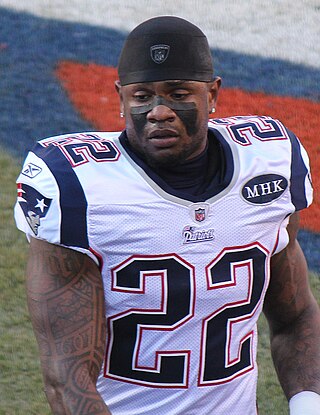
Stevan Todd Ridley is an American former professional football player who was a running back in the National Football League (NFL). He played college football for the LSU Tigers and was selected by the New England Patriots in the third round of the 2011 NFL draft. Ridley was also a member of the New York Jets, Detroit Lions, Indianapolis Colts, Atlanta Falcons, Denver Broncos, Minnesota Vikings and Pittsburgh Steelers. With the Patriots, he won Super Bowl XLIX over the Seattle Seahawks.
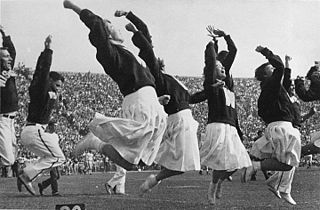
The 1956 Wisconsin Badgers football team was an American football team that represented the University of Wisconsin in the 1956 Big Ten Conference football season. In their first season under head coach Milt Bruhn, the Badgers compiled an overall record of 1–5–3 record with a mark of 0–4–3 in conference play, placing ninth in the Big Ten.

The 1956 Illinois Fighting Illini football team was an American football team that represented the University of Illinois during the 1956 Big Ten Conference football season. In their 15th year under head coach Ray Eliot, the Illini compiled a 2–5–2 record and finished in a tie for seventh place in the Big Ten Conference.
The 1964 Big Ten Conference football season was the 69th season of college football played by the member schools of the Big Ten Conference and was a part of the 1964 NCAA University Division football season.
The 1956 Big Ten Conference football season was the 61st season of college football played by the member schools of the Big Ten Conference and was a part of the 1956 college football season.
The 1977 Big Ten Conference football season was the 82nd season of college football played by the member schools of the Big Ten Conference and was a part of the 1977 NCAA Division I football season.
References
- ↑ Pitman, Michael D. "NFL player, long-lost friend reconnect in Middletown". journal-news.
- 1 2 Craig, Mark (October 22, 1999). "Hamner's time". Star Tribune – via Newspapers.com.

- 1 2 Craig, Mark (October 22, 1999). "Hamner's time (continued)". Star Tribune – via Newspapers.com.

- ↑ "Thomas Hamner Stats". Pro Football Archives.
- 1 2 "Gophers 30, Northeast Louisiana 3". Star Tribune . September 8, 1996 – via Newspapers.com.

- ↑ "Analysis (continued)". Iowa City Press-Citizen . November 23, 1996 – via Newspapers.com.

- 1 2 Elder, Andy (October 19, 1997). "Gophers' fumble sets up winning TD". Centre Daily Times – via Newspapers.com.

- ↑ Yanoshak, Ryan (October 19, 1997). "Daniels steps up for Lions/Lions (continued)". Citizen's Voice – via Newspapers.com.

- 1 2 Roe, Jon (October 30, 1997). "Hamner backs of threat to transfer". Star Tribune – via Newspapers.com.

- 1 2 3 "Thomas Hamner College Stats". Sports-Reference.com.
- ↑ Zgoda, Jerry (September 12, 1998). "Nice change of direction". Star Tribune – via Newspapers.com.

- ↑ "Hamner finds holes for Minnesota as Memphis falls hard". Argus-Leader . September 20, 1998 – via Newspapers.com.

- ↑ Reusse, Patrick; Craig, Mark (October 17, 1999). "Hamner just keeps piling up yards at the 'U'". Star Tribune – via Newspapers.com.
{{cite news}}: CS1 maint: multiple names: authors list (link)
- ↑ Lefko, Jim (October 31, 1999). "Hamner enjoys big day against Boilers". Journal and Courier – via Newspapers.com.

- ↑ Comer, David (November 7, 1999). "Making amends". Centre Daily Times – via Newspapers.com.

- ↑ "2000 NFL Draft Listing". Pro-Football-Reference.com. Retrieved March 19, 2023.
- ↑ "2000 NFL Draft". Pro Football Archives.
- ↑ Brewer, Jerry (August 4, 2000). "NFL life sweet as candy to graduate of hard times". The Philadelphia Inquirer – via Newspapers.com.

- ↑ "Football (transactions)". Press and Sun-Bulletin . November 25, 2000 – via Newspapers.com.

- ↑ Latty, Yvonne (May 11, 2001). "Eagles player on the run". Philadelphia Daily News – via Newspapers.com.

- ↑ "Eagles Release Troubled Back". Statesman Journal . May 22, 2001 – via Newspapers.com.
